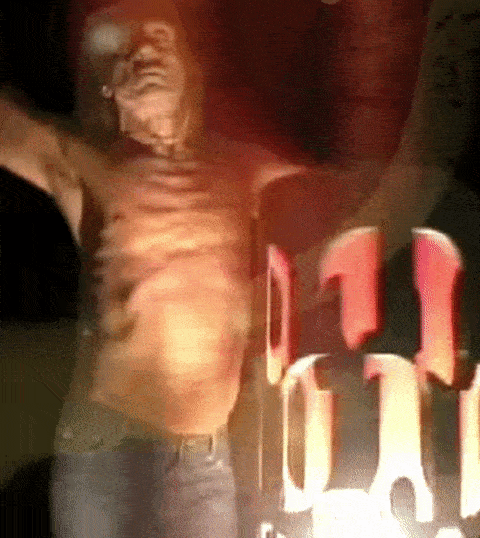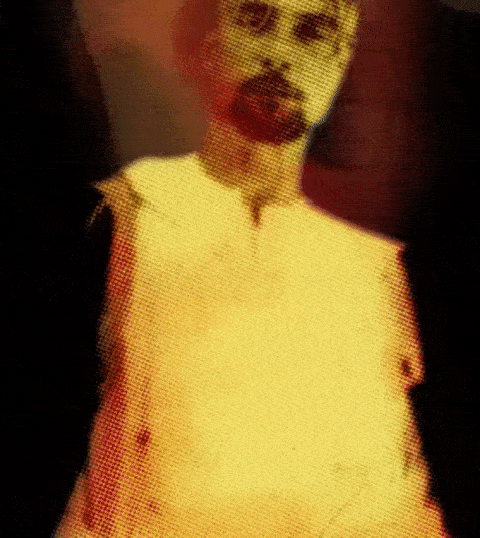Flicker

The story
“Really, I think, behind everything, he was trying to teach people to see differently.”
Genesis P-Orridge, on Brion Gysin
The dream machine looks simple enough: A 100-watt light bulb, a motor, and a rotating cylinder with cutouts. Just sit in front of it, close your eyes, and wait for the visions to come. The dream machine offers a drugless high that its creator – poet, artist, calligrapher and mystic Brion Gysin – believed would revolutionize human consciousness. He wasn’t alone. Kurt Cobain had a dream machine. And William S. Burroughs thought it could be used to “storm the citadels of enlightenment.” With a custom-made dream machine in tow, director Nik Sheehan takes us on a journey into the life of Brion Gysin – his art, his complex ideas, and his friendships with some of the 20th century’s key counterculture figures. Gysin was fascinated by identity. He saw himself as a incarnation of the 10th-century King of Assassins, trained in counter-espionage during WWII, and wrote and rewrote his name in countless permutations, as if to make it disappear – in the process, inventing the cut-up technique that his lifelong friend, Beat novelist Burroughs, would make famous. Featuring greats like Burroughs (in archival footage), singer Marianne Faithfull, singer/artist Genesis P-Orridge of Psychic TV, poet John Giorno, rocker Iggy Pop, filmmaker Kenneth Anger, and artist/turntablist DJ Spooky, FLicKeR is a hypnotic documentary. Taking the dream machine as the basis of its explorations, FLicKeR asks crucial questions about the nature of art and consciousness, and imagines a humanity liberated to explore its creativity in complete freedom.

Who is Brion Gysin?
Brion Gysin (1916-1986) was a multimedia artist and mystic most famous in his lifetime for inventing a system called The Cut Ups, often credited to his best friend and soul mate the Beat writer William S. Burroughs. Traversing many nationalities, Gysin was a Sufi initiate, Secret knowledge. Dream Machine 1960 at the Beat Hotel after experiencing flicker near Marseilles tried everything to market and sell his ticket. Control systems kif. Yes? Hello? Aligned with Breton’s surrealists but to crushing defeat, taken off the wall the night before, doubts remain. Morocco Atlas mountains Jajouka musicians Brian Jones recorded died Kurt Cobain had a Dream Machine. I am That I am. Junk is no good baby. Grid patterns. Hassan I Sabbah. Man is a bad animal. Nothing is true. Everything is permitted.
What is Flicker?
The flicker effect was identified by the famously independent-minded scientist W. Grey Walter in his best- selling 1953 book The Living Brain. Grey Walter – who was soon to become the father of Artificial Intelligence – discovered that by using high-powered stroboscopes and experimenting with trigger feedback techniques where the flash was set to fire in synchronization with the brain’s rhythms, the brain is, “transformed temporarily to a different sort of brain.” Walter found that time itself could become lost or disturbed. As he observed of one subject: “[He had] the sense of having been pushed sideways in time by flicker. Yesterday was no longer behind, and tomorrow was no longer ahead..” Stroboscopic light, or light flashing on the eye between 8 and 13 flashes per second, induces alpha wave activity in the brain – a state normally associated with dreaming and creativity. Subjects often report seeing shapes and colours, some have full-blown hallucinations, others mystical experiences. Approximately one in 4,000 people will have an epileptic seizure. In 1997, ten million Japanese schoolchildren, and some adults, tuned into the animé cartoon Pokemon to see a “flashing explosion with high frequency red and blue flicker stimulation” hit the screen and persist. What happened next sparked international headlines. Some viewers went into a trance-like state, as if hypnotized. Others experienced altered vision and shortness of breath. Some passed out, others had seizures. Hospitals all over Japan received admissions, though nobody was permanently damaged.
Film Director, Nik Sheehan
Nik Sheehan is a Toronto-based director, writer and producer. Prior to FLicKeR, he made a critically acclaimed and widely broadcast study of artist and teacher Paul Young, The Drawing Master (2005).
Earlier acclaimed documentary features, which played in major festivals and were nationally broadcast, include the story of renegade artist Scott Symons in God’s Fool (1997), and Symposium: Ladder of Love (1995), a revisiting of Plato’s classic with a cast of well-known Canadian artists and writers.
He established an international reputation in 1985 with No Sad Songs, the world’s first major documentary on AIDS.
Sheehan has worked as a journalist and literary critic.
Comments
Bastiaan C. ter Meulen
Can a documentary change your life? In my case it did. As the dreamachine is on the interface between science and the arts, it drew me out of the determined world of knowledge (through consciousness) into the dynamic world of experience (preceding any form of consciousness), a transition from a sometimes rather small horizon towards the genuine borders of being; not only the Beats, but also Genesis-P or Iggy have been and still are an inspiration this way to open up the metaphorical “reduction valve of the mind”
Marcus Boon
Brion Gysin’s Dream-Machine: a pioneering psychedelic spiritual artwork that baffled and fascinated the best minds of the 1960s, many of whom appear in this movie, and whose day may finally have come today. Sheehan’s great success here is to focus not only on the curious history of the Dream-Machine, but to explore its effects on people today as a living, pulsating piece of machine magic.
John Geiger
In FLicKeR, Nik Sheehan exposes the scientific discovery that flashing light at specific intervals can induce an altered state of consciousness, and tells the story of one man’s attempt to subvert the forces of control by placing a Dream Machine in every suburban living room. Either subject alone would have made for a radical film. Together they represent a threat to the established order.

The Flickerites
Written and Directed by
Nik Sheehan
Produced by
Maureen Judge
Produced by
Anita Lee
Associate Producers
Brian Cullman Christina Clarke
Executive Producer for the National Film Board of Canada
Silva Basmajian
Based on the book Chapel of Extreme Experience:
A Short History of Flicker by John Geiger
Director of Photography
Harald Bachmann
Editors
Caroline Christie Miume Jan Eramo
Original Music by
Edmund Eagan
Featuring
Kenneth Anger Marcus Boon Udo Breger Catherine Clément Ira Cohen Brett Despotovich John Dunbar Sophie Duplaix Marianne Faithfull John Geiger John Giorno Rhodri Hayward Michael Innanen Jean-Jacques Lebel Leila Hadley Luce Richard Metzger Bastiaan ter Meulen Madame Odillard Genesis P-Orridge Katherine Piro Lee Ranaldo Ira Silverberg DJ Spooky Iggy Pop and the Stooges Psychic TV Floria Sigismondi Terry Wilson Nick Zinner
Sound Recording
Brett Despotovich Jason Milligan Hartley Wynberg
Sound Editing & Design
Mark Gingras John Laing Dale Lennon Jan Rudy
Rerecording & Design
Daniel Pellerin
Visual Research
Kristina Howard
Assistant Editors
Paul Hasick Leanne Young Ryan Noth
Production Accountant
Sam Simpson
Production Coordinator
Ashley Lannigan
Production Assistants
Brett Despotovitch Katherine Piro
Produced by Makin’ Movies Inc.
In co-production with the National Film Board of Canada
Produced and Developed in Association with
BRAVO! A division of CTV Limited

Produced with the participation of the Canada Television Fund

Created by the Government of Canada and the Canadian Cable Industry
Developed with the Participation of Telefilm Canada

Produced with the assistance of the Canadian Film or Video Tax Credit

And
with the assistance of the Government of Ontario
–
The Ontario Film & Television Tax Credit

Creative Consultant
Ben Schaub
Paris Fixers
Alain Couture
“Magic” Thierry Chompré
Equipment Rental
Bullet
Trew Audio
Offline Editing
CeLL Productions
Online Editing
Imarion
Animation House
Ghost FX
Rerecording Facility
Urban Post Production
Technical Support
Richard Vandentillaart
Stills Photography
Nik Sheehan
Graphic Design
Mark Lambert
Interim Financing
The National Bank of Canada
For Makin’ Movies
Associate Producer
Leslie Valpy
Production Assistant
Jacob Engel
Sabreena Peters
For The National Film Board of Canada
Production Coordinator
Christine Kleckner
Corinne Herman
Production Supervisor
Mark Wilson
Website Design
Richard Luong
Stock Footage Courtesy of
BBC Udo Breger
Genesis P-Orridge
Tony Conrad
The Hartley Film Foundation James Grauerholz
Canamedia/ITN Source MacDonald & Associates
“The Master Musicians” courtesy of Mendizza & Associates
National Film Board of Canada
Ponopress The WPA Film Library
Special Thanks
Diane Boehme Tony Conrad
Donna Cowan David Craig
Charlotte Engel Hassan Hakmoun
Sam Hiyate Jay Ingram
Michael Luong Zoe Mainville
Sue Mander Ron Mann
Barry Miles Richard Nash
Thomas Neurath Gehlek Rimpoche
Ned Rorem Kevin Sheehan
Margaret Sheehan Michael Snow
Leslie Stafford Monica Szenteszky
Joshua White Martin Waxman
Cameron House, Toronto
Centre Pompidou, Paris
Discovery TV
Galapagos Artspace, New York
Musee des Arts Moderne Paris
National Screen Institue
NFB Mediatheque, Toronto
Relais Hôtel de Vieux Paris
Victoria and Albert Museum of Science, London
Whitney Museum of American Art
Produced by Makin’ Movies Inc.
In co-production with the National Film Board of Canada
Produced and Developed in Association with
BRAVO! A division of CTV Limited

Produced with the participation of the Canada Television Fund

Created by the Government of Canada and the Canadian Cable Industry
Developed with the Participation of Telefilm Canada

Produced with the assistance of the Canadian Film or Video Tax Credit

And
with the assistance of the Government of Ontario
–
The Ontario Film & Television Tax Credit

Press Articles
Jason Anderson
“Captivating” (four stars)
Guy Dixon
“A high degree of knowing nuttiness.” (3 1/2 stars – out of four)
Daily Xtra
“Amazing… A fascinating voyage into the life of artist and mystic Brion Gysin and his legendary invention the dream machine…”

